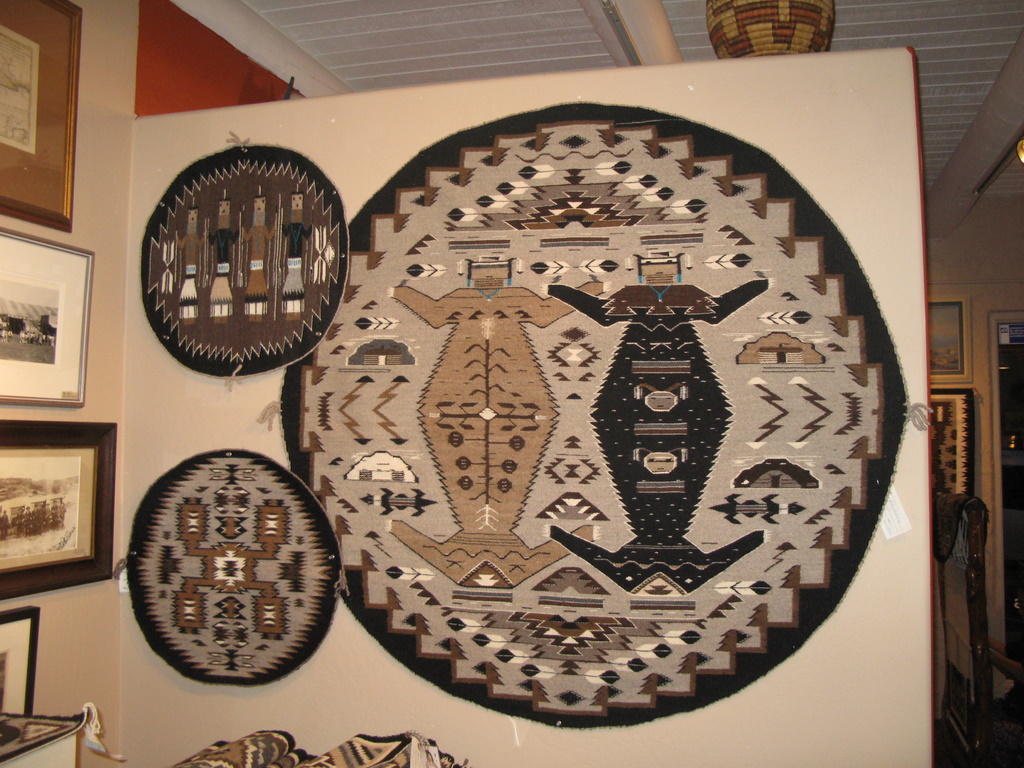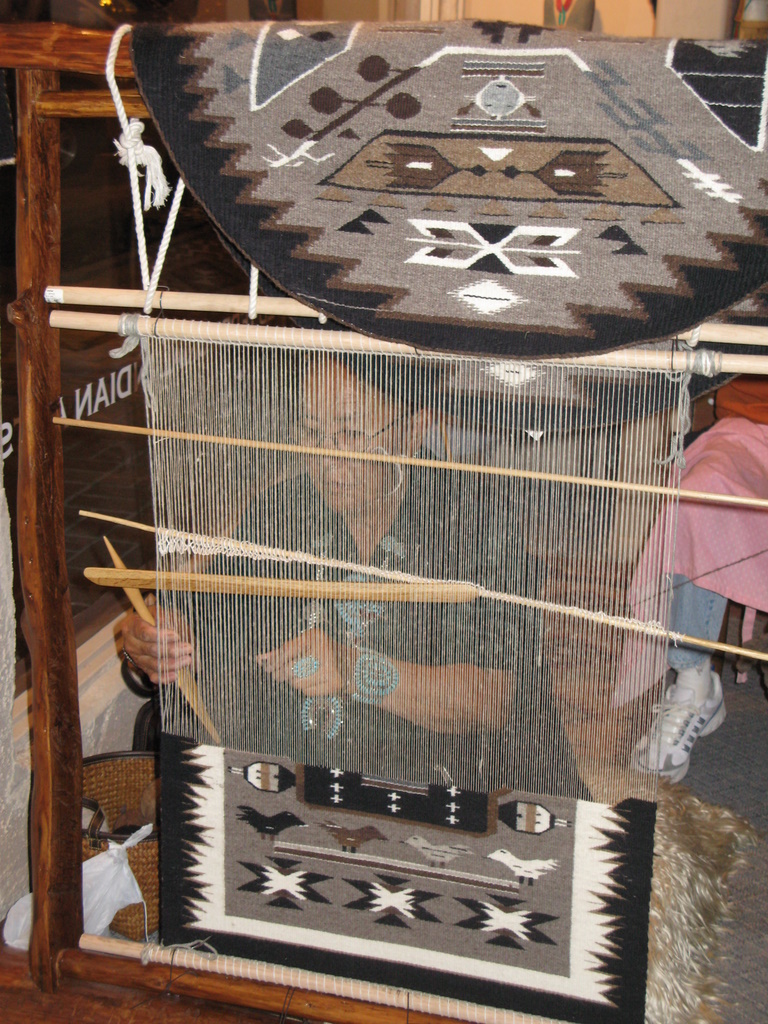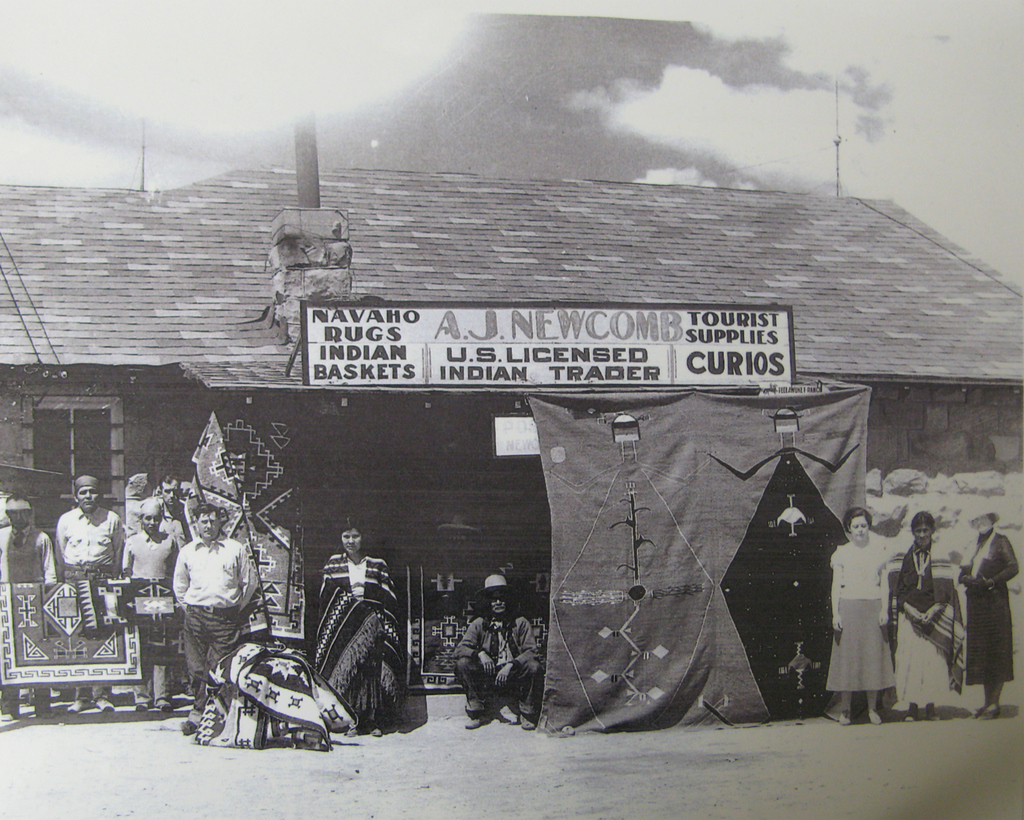A Round Sandpainting Rug by Marie H. Yazzie and An Encounter with Hastiin Klah
A magnificent image of Mother Earth and Father Sky dominates this picture of the weavings of Mary H. Yazzie
Tempe, AZ I always spend longer than I plan to in the Toadlena/Two Grey Hills area and I came across the picture above when I was scouting out the Evelyn George picture in the previous entry. To weave a round rug using Navajo techniques is to be initiated into some closely guarded secrets for both warping and weaving. There are probably fewer than 20 weavers who can produce a marketable round textile and only a very, very few who can achieve the design sophistication shown in the weavings above by Mary H. Yazzie of Sanostee, NM. The design depicts Mother Earth and Father Sky, who embody the universe. Mother Earth holds the four sacred plants: corn, beans, squash and tobacco. The Sun and Moon appear within Father Sky on the background of the Milky Way. Hogan designs indicate the four directions of the Navajo compass and signify the Four Sacred Mountains. This design would be spectacular on a conventional rug; on a round piece, it is astounding. Did I mention that it is hand spun? Mary’s daughter Marilyn does most of the spinning for her mother and frequently accompanies her when she demonstrates weaving at shows and events. Mary’s work is sold through the Toadlena Trading Post.
The use of sandpaintings as a design source for weaving goes back to another resident of the Two Grey Hills area, the legendary Hastiin Klah, a great grandson of the equally legendary Navajo leader Narbona Tso. Klah was a noted singer or hataáłii. He was born in 1867 near Ft. Wingate, as his family was beginning their return from the Long Walk. As he matured, Klah became very concerned about the rate at which traditional ceremonies and their accompanying chants and sandpaintings were being lost to the onslaught of assimilation. Klah’s concerns were shared by his close friend, Frances (Franc) Newcomb, the wife of trader A.J. Newcomb. Newcomb’s book on Klah, Hosteen Klah: Navaho Medicine Man and Sand Painter is the definitive work on his life.
Hastiin Klah’s obsession, shared by Franc Newcomb, became the documentation and preservation of Navajo ceremonial life. As Klah sought ways to permanently depict the sandpaintings that draw the necessary deities to a particular place, he realized that they could be woven as well as drawn. This idea and the whole idea of any type of record of the traditional ceremonies was and still is anathema to some in the community. Klah and Newcomb persisted, however, with Klah emphasizing that these textiles were not intended to be walked on and were part of an effort to preserve these designs for the future. At the same time, Klah’s textiles were avidly sought by collectors and he initiated two of his nieces in the chants and protections needed for them to weave in this style, so there are those who believe that his motives were more market driven than cultural. As the most respected living hataáłii, Klah had the stature to ignore the criticism and do what he thought appropriate. Klah’s work attracted the attention of Mary Cabot Wheelwright and he collaborated with her as a founder of the Wheelwright Museum in Santa Fe., NM. The picture below is thought to show Hastiin Klah seated to the left of one of his weavings, a Sandpainting design showing Mother Earth and Father Sky.
Hastiin Klah seated to the left of a Sandpainting weaving. Franc Newcomb appears at right. A.J. Newcomb is in the white shirt at left. The Navajo people are thought to be relatives of Hastiin Klah. The young Anglo woman is the Newcomb’s daughter. You can hover your mouse over the picture for a closer view. Thanks to Les Wilson at the Two Grey Hills Trading Post for allowing me to photograph this historic photo.
And as usual, I’ve stayed longer than I’d intended in Two Grey Hills. I hope you can see how it can happen.
Hagoshíí (so long for now)
Mary Walker




hey Mary, This is an exceptional article! Thanks for sharing your knowledge!! Kathy
Thanks for the explanation, Mary. Maybe one of these days you’ll feel comfortable offering the round weaving techniques in one of your classes.
In the case of the round rugs, there group that weaves them is very small and they haven’t experienced the problem of rejection when they choose to pass along the techniques. Many other weavers have no one in their family who wants to learn and come to believe that the knowledge should be passed on, no matter what the ethnicity of the student.
Mary, just some random thoughts about weaving round rugs. How is it that the Navajo weavers don’t seem to mind their techniques on the traditional Navajo loom taught, but not the round loom? It’s not like our rugs woven in the Navajo manner diminish the value of their rugs. We respect the process of weaving, even though we are not Navajo ourselves. What difference does the shape make?
Kathy
It’s always fun to see the rugs you choose for your Rug of the Day items, but this extra bit of history made the posting even better. Thanks Mary.
The people who weave these really don’t want the techniques made known, so they’re very closely guarded. I respect their wishes, but like Hosteen Klah, I’m worried about things getting lost.
I always appreciate the history of a rug and the weaver who made it.
Thanks Mary for giving us this information.
Just curious, are you one of the select few who knows how to warp and weave a circular rug?